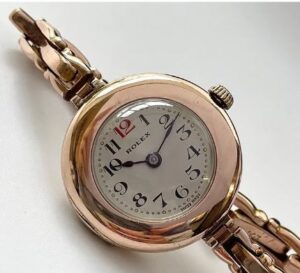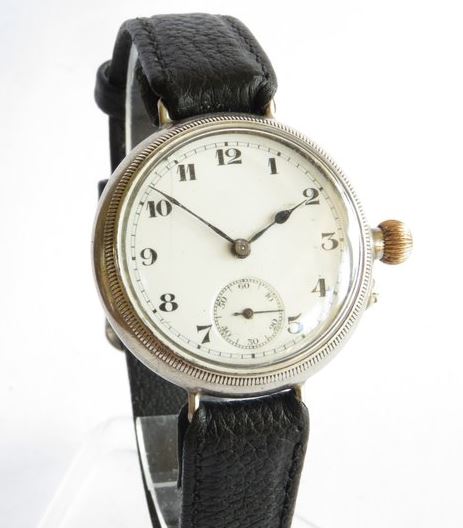Last updated on November 16, 2025
The period between 1910 and 1920 profoundly reshaped watchmaking. This decade witnessed a significant shift in watch design. Pocket watches had long dominated the market. However, wristwatches began their ascent to widespread popularity. In this post, we explore the watch revolution that took place in the years 1910-1920.
Wristwatches gained popularity during this period as a direct result of the introduction of the trench watch during WW1. Prior to the war, ladies typically wore wristwatches or “wristlets” as they were known. Gentlemen generally preferred pocket watches. This highlights a strong societal perception. The shift to men wearing them was not a natural evolution. Instead, it represented a forced, functional change.
The rise of the wristwatch: the impact of war
The Great War popularised wristwatches amongst soldiers. These devices offered significant practical advantages over pocket watches. Soldiers needed quick, hands-free access to read the time. Fumbling for a pocket watch was impractical in trenches. A wristwatch allowed immediate time checks. This convenience freed a hand for other tasks, and it became essential for coordinating manoeuvres.
At the start of the war, soldiers began wearing modified pocket watches on their wrists. They soldered lugs onto these watches for straps. The “trench watch” became a key development. It was also known as a “wristlet”. Given that wristwatches were previously seen as “effeminate”, their adoption by soldiers transformed their image. They became “symbols of masculinity”. This cultural shift was a direct consequence of their military utility (The Ironic Elegance Of Trench Watches at Hodinkee).
Trench watch design features
Trench watches exhibited distinct characteristics. These features prioritised durability and readability. Wire loops on the casing are attached to straps. These were early forms of lugs. Watch hands and dials often featured luminous coatings. This ensured visibility in the dark. A large, protruding crown allowed winding. Soldiers could operate it without removing gloves. The crystal often had a hinged cage for protection. This design element carried over from pocket watches. These crystal guards prevented shattering. Mineral glass crystals were relatively fragile. Some trench watches had a centre second hand. Medics used these to measure patient pulses. The specific design features directly addressed practical challenges. These included darkness, fumbling with gloves, and fragile glass.
Evolving case designs and durability
The decade also saw significant efforts to enhance watch durability. Watchmakers sought to protect movements from elements. Hunter and half-hunter wristwatches appeared during this time. These styles featured metal lids over the crystal. A hunter case has a metal lid covering the dial. It protected the fragile crystal. A half-hunter case includes a small window. This allowed the time to be read without opening the lid. Hunter and half-hunter cases were effective for pocket watches. However, they proved impractical for wristwatches. The advantage of an open-faced wristwatch was the ease with which the time could be read.
Pioneering water-resistant cases
The conditions of the trench called for water resistance, and the watchmaking industry pursued the goal of waterproof watches. This goal would not be achieved until the 1920s. However, early models were stepping stones.
François Borgel patented a screw watch case in 1891. This design became widely used during World War I. The Borgel case was a one-piece screw-in design. It aimed to be dustproof and waterproof. The movement and bezel are screwed into the case from the front. Officers bought Borgel wristwatches for trench life. They were more expensive but offered better protection. These watches often remain in better condition today. Electa and Longines were early adopters (Borgel and Taubert at WahaWatches).
Tavannes introduced the Submarine watch in 1915. It was made watertight by having a screw-on caseback and bezel, which were fitted with gaskets. Additionally, there was a waterproof seal in the pendant, where the winding stem connected to the crown. This was the area that watchmakers found most difficult to seal (Tavannes Submarine at Time + Tide).
Materials
Watch design during this decade reflected both tradition and emerging trends. Materials and movements saw continuous refinement. Circular forms were typical for watch cases. Silver and gold were prevalent materials, although nickel was available as a hard-wearing alternative. Dials were almost universally hard-glazed enamel, which is stain-resistant. However, enamel dials were brittle. They fractured easily from shock. Mineral glass crystals were common, although these were relatively fragile. Shatter-resistant acrylic, advertised as “Unbreakable”, was available, particularly for trench watches. However, the acrylic tended to “yellow” with age.
Emerging Case Shapes
While circular cases dominated, new shapes began to appear. This period saw early experimentation. The cushion shape emerged as a cross between a square and a circle. The Tonneau shape was another non-traditional design. Louis Cartier created Tonneau-shaped cases. Vacheron Constantin and Patek Philippe also introduced their versions. Despite the dominance of circular forms, the emergence of cushion and Tonneau shapes signifies a deliberate move towards stylistic diversification. This was not merely about function. It indicates that as the wristwatch gained acceptance, manufacturers explored its potential as a fashion accessory (Watch case shapes at WatchGecko).
Beyond the battlefield
The decade was dominated by the First World War. The wristwatch’s military success quickly translated to civilian life. Its newfound utility led to widespread popularity. The wristwatch became a fashion statement. The immediate post-war period saw widespread public acceptance of the wristwatch. This directly followed its adoption by soldiers. This indicates a “trickle-down” effect. Military endorsement, driven by practical necessity, legitimised the wristwatch for civilian use. It transformed it from a niche item to a mainstream accessory (The Invention of the Wristwatch at SwissWatchExpo).
A decade of innovation
The decade from 1910 to 1920 profoundly impacted watchmaking. It revolutionised personal timekeeping. World War I served as a powerful catalyst. It accelerated the wristwatch’s evolution. The “trench watch” was a crucial transitional design. It prioritised durability and readability. Innovations in case design laid the groundwork for waterproofing. The era saw the wristwatch transform. It moved from a niche item to a mainstream necessity. This period cemented the wristwatch’s future. It became a practical symbol of both utility and style.



